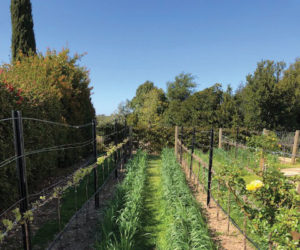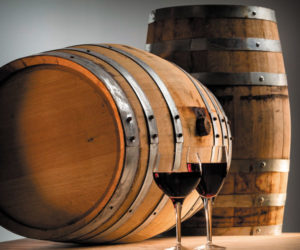Q I am using Flextanks and oak chips for my wine and am really liking the results. However, I put the oak chips in loose and they clog up the tubing and pump when I rack. I was thinking of making some bags out of mesh to put the oak chips in, but was wondering about the mesh fabric, imparting flavor to the wine. The fabrics I have found are nylon or polyester. Would either of these be a problem in wine? (The reason I’m not switching to oak cubes or spirals is I have a huge bag of oak chips already.)
Marianne Pariseau LeSage
Spokane, Washington
A Like you I find oak pieces (segments, beans and sometimes chips) are a great way to practice elevage (aging and development) with small lots that won’t fit into a 60-gallon (227-L) barrel or for larger lots where I just don’t want the hassle of barrels. If you’re using small pieces of wood in winemaking, you guessed it, it’s a heck of a lot easier to work with them if you confine them to a bag or a sack of some kind. My non-coopered oak supplier of choice, Stavin (based in California) packs their oak beans and segments in food-grade nylon bags. These puppies are big however, weighing in at 20 lbs. (9 kg) each and are way too large for most home winemakers.
So get creative with your oak bagging! I shop at my friendly home winemaking store in Napa and (gasp!) even meander over to the brewing section to pick up some food-grade nylon mesh bags of various sizes. Friends of the Wiz use them for infusing hops or grain in their brews but I use them for containing my oaky bits. You can also find these bags online, again through home winemaking and homebrewing websites.
Don’t want to buy something new? I’m not sure if the nylon you mention above is technically “food grade” but in a pinch I’ve known people to use nylon stockings, loose-weave, undyed cotton fabric like muslin (all natural material so nothing will leach into the wine) or several layers of cheesecloth (undyed cotton).
If your chips are small, a very loose-weave fabric like cheesecloth will definitely need to be layered several times to keep any little oak pieces from coming out and getting into your wine. Simply measure out how many oak chips you need (I tend to figure, for young red wine, starting with 2 g/L ), cut enough fabric to hold them (you can even split up your dose into two bags if you are adding a lot) gather up the oak into a ball and secure with undyed cotton twine, fishing line or other strong neutral tying material and suspend the ball in your wine. If I’m making wine in a small stainless steel tank with o-rings welded on the inside, I’ll actually tie the ball to the o-ring before filling the tank. This keeps the bag submerged in the wine, where it will do the most good. Also, you can weight your bags with spare stainless steel fittings, clamps or endcaps — I always have a few spares hanging around the garage because they’re what I use to seal my small stainless topping kegs.
Just make sure that whatever you put into your wine won’t leach anything or break off into small pieces. Stainless steel is safe, as are “food grade” plastics, non-lead ceramics and pyrex. As far as the oak pieces or chips go, make sure that you shop around and try lots of different brands. I have found large differences in quality between suppliers; some products seem to be nothing more than the sweepings from the barrel shop floor! Don’t forget that the smaller the oak particles, the faster the wood character will extract and, in my experience at least, the harsher the finished product. For longer-term aging, try bigger segments (around 2 inch X 0.5 inch/5 cm X 1 cm). Suppliers are coming up with new types of non-coopered oak all the time so keep checking in.
Q I have a half ton of Merlot in my garage in a barrel that seems to be getting some volatile acidity from taste. I’m getting it tested now. What is the best way to fix my wine if this is the case?
Luke Chiurco
Santa Rosa, California
A Short answer (and it might work if your volatile acidity (VA) level is low enough, say, under 0.55 g/L, depending on your sensory threshold) is to bump up your free SO2 and see if the smell goes away. Sometimes what we perceive as “VA character” can actually come from aldehydes, which get bound up with sulfur dioxide. Often that’s all it takes to make the “VA smell” and taste (which are intimately connected in our sensory world) go away or diminish to a point where the wine is acceptable to you.
However, when you get VA or aldehyde in your wine (which can come from many different sources too numerous to recount in this part of the column you should see it as a very large flag of the red persuasion, if you know what I mean. It generally means that you’ve got someone growing in there that you don’t want and it also possibly means that your wine is not as topped up (completely full in the barrel) as it should be.
Bacterial infection, oxidation and VA all go hand in hand so if you bump up the SO2 and that helps (and even if it doesn’t!) you should make sure that your storage containers are completely topped up. Some of us keep smaller breakdown jugs and stainless kegs for this purpose but if you don’t have any similar wine to top up with, see if one of your winemaking buddies does (I always lend a guy at work some of my spare tank samples) or last but not least, go and buy some similar wine (same varietal, same year, if possible) at the store. However, the best thing is always to make a little more than you think you’ll need, or to use some similar wine from your own stash, to remain as authentic as possible to your wine. Of critical importance is not to blend in any wine that is itself infected with spoilage organisms or has residual sugar or malic acid, because that’s like inviting some unwanted guests for a re-fermentation party.
Additionally, while you’re sending a wine sample out for a VA test, you might want to get the pH, TA, alcohol, residual sugar and free and total SO2 levels tested if you don’t have a good handle on those numbers either. I know it sounds like a lot, but to get an idea of how to best “fix” your wine and especially how to prevent it in the future, these are important parameters to know. First of all, the pH and TA will tell you how much acid you have in the wine. At lower acidity levels (say, pH above 3.70 or TA below 0.45) bacteria will be more likely to live and thrive in your wine, a good way to increase VA, or volatile acidity.
The alcohol level can also tell you some information; bacteria are inhibited by higher alcohol levels so if your Merlot is lower than 11%, that might also be contributing slightly to your problem. The RS and malic acid content are important because if you’ve got a stuck fermentation (where the yeast didn’t consume all the sugar or your lactic acid bacteria didn’t consume all of the malic acid), your VA problem might be from the aforementioned microbes trying to finish the job under adverse conditions. VA (and sometimes other stinky compounds like hydrogen sulfide) can be fermentation byproducts excreted by cranky microbes, which can only be removed with sterile filtration.
Get your free and total SO2 tested because you want to make sure that all the other numbers being in the normal range and your wine topped up, you are storing your wine with enough sulfur dioxide to keep microbial growth and oxidation at bay. Every winemaker has a different answer for “what is high enough but not too high” in the land of SO2 adjustment. Too high and you can start to bleach color from red wines and notice it in the aroma and taste. Too low and it’s just not enough to be effective against bacteria and spoilage yeast. You have to look at the pH of your wine too. The higher the pH, the more SO2 you have to add (go to www.winemakermag.com/guide/sulfite to calculate your sulfite additions). Typical levels of desirable free SO2 for whites that have elevated VA is 30–35 mg/L and 28–30 mg/L for reds. However, if the pH is higher than 3.50, I would suggest you bump it up by a few mg/L and keep an eagle eye on your topping.







